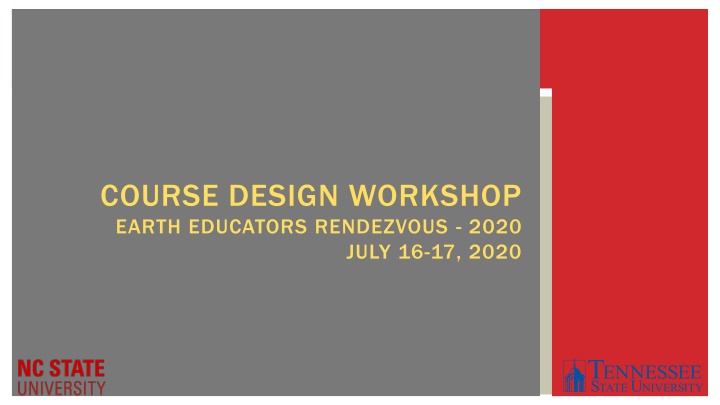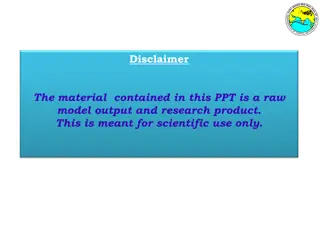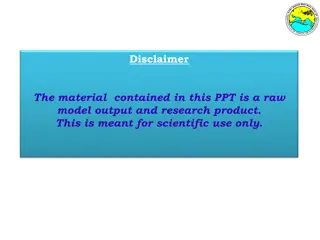
Effective Strategies for Inclusive Classroom Design
Explore key aspects of creating an inclusive college classroom environment through strategies like promoting diversity, utilizing backward design, and crafting meaningful learning objectives and assessments. Engage in interactive sessions on inclusivity and collaborative learning to enhance student participation and community building. Gain insights on fostering an inclusive space where all students feel respected and valued.
Download Presentation

Please find below an Image/Link to download the presentation.
The content on the website is provided AS IS for your information and personal use only. It may not be sold, licensed, or shared on other websites without obtaining consent from the author. If you encounter any issues during the download, it is possible that the publisher has removed the file from their server.
You are allowed to download the files provided on this website for personal or commercial use, subject to the condition that they are used lawfully. All files are the property of their respective owners.
The content on the website is provided AS IS for your information and personal use only. It may not be sold, licensed, or shared on other websites without obtaining consent from the author.
E N D
Presentation Transcript
COURSE DESIGN WORKSHOP EARTH EDUCATORS RENDEZVOUS - 2020 JULY 16-17, 2020
Learning Objectives 1. Describe strategies to promote an inclusive college-level classroom 2. Explain the principal components of the backward design process 3. Analyze sample learning objectives and assessments. 4. Write learning objectives and design assessments for new lessons
Schedule 8:00-8:15 Introductions Reginald & Jason 8:15-8:30 Icebreaker You will be randomly assigned to a breakout room. Get to know your room mates and find at least two things all five of you all five of you have in common!
Schedule 8:30-8:35 Icebreaker report out! 8:30-9:30 Strategies for promoting classroom inclusivity
CLASSROOM INCLUSIVITY Arguably one of the most important features of an effective course is students ability to feel welcome and valued in the environment The question is how can we as how can we as instructors create an instructors create an inclusive inclusive environment? environment?
Inclusivity Strategies Jigsaw Split into breakout rooms, read (one strategy per person) and discuss each strategy as a small group Group 1: Strategies 1-5 Group 5: Strategies 1-5 Kotokowski, Garnier, Whittington, Goldsmith, Farrell Group 2: Strategies 6-10 Abolins, Peebles, Blome, Fung, Phillps Group 6: Strategies 6-10 Wysession, Abshire, Snyder, Pricope, Wang Group 7: Strategies 11-15 Horsman, Bigio, Klosko, Haile, Marton Group 3: Strategies 11-15 Low, Goldhagen, Benner, Knox, Cantner Group 4: Strategies 16-21 Cohen, Davies, Yun, Sheffield, Mostarshed Group 8: Strategies 16-21 Ross, Fredrick, Courtland, Falkena, Gonzalez Back here to report out at 9:00! Watson, Traub-Metlay, Lepore, Isava, Sun
Inclusivity Strategies Discussion What did you learn?! Category 1: Giving students opportunities to think and talk about the topic Category 2: Encouraging and actively managing the participation of all students Category 3: Building an inclusive and fair classroom community for all students Strategies 1 Strategies 1 - - 4 4 Strategies 5 Strategies 5 - - 10 10 Strategies 11 Strategies 11 - - 15 15 Category 4: Monitoring behavior to cultivate divergent thinking Category 5: Teaching all of the students in your biology classroom Strategies 16 Strategies 16 - - 19 19 Strategies 20 Strategies 20 - - 21 21 9:15-9:30 Reginald discusses his experiences
Schedule 9:30 9:45 BREAK
WHAT DBER TELLSUSABOUT TEACHINGFOR LEARNING 1. Students learn key concepts better when they actively monitor their understanding in a variety of activities inside and outside of class (designed, structured activities). 2. Students become better learners when we challenge them to answer questions that require the use of higher order thinking skills. 3. Knowledge is socially constructed and people learn best in supportive social settings (e.g., in small collaborative groups). Classes with these practices may be described as reformed or student or active learning environments or using research or active learning environments or using research- -based instruction reformed or student- -centered based instruction centered
IDENTIFYING LEARNING OUTCOMES Recognizing that we haven t formally discussed it yet, try writing five learning outcomes for your target course 9:45 9:55
IDENTIFYING LEARNING OUTCOMES Learning Goals vs. Learning Objectives What s the difference? Learning goals Learning goals (4-8 per semester) broad, several concepts. Designed to guide course (e.g., Students will be able to use data to guide scientific argument) broad, larger goals that include course development Learning objectives Learning objectives (~100 per semester) for activities/lessons your courses that would support the learning of a single important concept important concept in your target course (e.g., I can explain how clastic sedimentary rocks are formed. activities/lessons in single
IDENTIFYING LEARNING OUTCOMES From your practice list, can you identify one learning goal target course? learning goal for your did you write any learning objectives learning objectives? Which did you write more of?
IDENTIFYING LEARNING OUTCOMES If you didn t in your first trial, write one learning goal target course learning goal for your Additionally, write one or two potential learning objectives activities in your courses that would support the learning of an important concept in your target course learning objectives for We will break out to our groups to discuss your objectives 10:00 10:10
EFFECTIVE LEARNING OBJECTIVES 1. Objectives should focus on the students, not the instructor. Teacher-focused goal: List of topics to be discussed in class Student-focused goal: List of learning objectives 2. What students will be able to do? (SWBAT) What will students have learned or be able to do by the end of the lesson that they don t know/can t do now? Students will be able to list names and proportions (%) of primary gases in the atmosphere Students will be able to differentiate between weather and climate information Students will be able to plot and interpret data in Matlab using the plot, max, and min functions http://serc.carleton.edu/NAGTWorkshops/coursedesign/tutorial/goals.html
EFFECTIVE LEARNING OBJECTIVES 1. Objectives should focus on the students, not the instructor. Teacher-focused goal: List of topics to be discussed in class Student-focused goal: List of learning objectives 2. What students will be able to do? (SWBAT) What will students have learned or be able to do by the end of the lesson that they don t know/can t do now? 3. Objectives should clearly demonstrate student learning. Learning should be visible, measurable. Include an action term (e.g., identify, explain, analyze, sketch, summarize) that requires students do something. Lesson learning objectives should be limited and specific. http://serc.carleton.edu/NAGTWorkshops/coursedesign/tutorial/goals.html
EFFECTIVE LEARNING OBJECTIVES 4. Match each learning objective with separate defined assessment task
Schedule 10:15 10:30 What is measurable?
SMART OBJECTIVE/GOALSETTINGCREATESA VERIFIABLETRAJECTORYTOATTAINTHEGOALS Effective lesson objectives should be: Specific not too broad, focused, targeted Measurable Students need to see progress, should feed into the outcomes Attainable/Actionable cant be too hard, too long Relevant/Realistic know your students, at their level of learning Time appropriate is it going to apply to one lesson or series of lessons
MEASURABLE GOALS Include precise amounts, dates, and so on in your goals so you can measure your degree of success. I.e. By the end of this lesson, students will be able to: Identify 4 types of earthquakes Describe the characteristics Distinguish between Example goal: Given live examples of five types of plants, the student will compare and contrast physical characteristics of plant structures (roots, stems, leaves, flowers, fruits, and seeds). Action: Compare and contrast Condition: Given live examples of five types of plants Mastery (success): they can compare and contrast physical characteristics of five of the six structures of different types of plants
USE BLOOMS TAXONOMYTOCONSIDERACTIONWORDS DESCRIBINGWHATSTUDENTSWILLDOANDLEARN Image from http://www.redwoods.edu/Departments/Distance/Tutorials/BloomsTaxonomy/
FINKSTAXONOMYCONSISTSOFSIXTYPESOF SIGNIFICANTLEARNINGCATEGORIES & SUB-CATEGORIES. Adapted from: Fink, L. Dee. Creating significant learning experiences: An integrated approach to designing college courses. John Wiley & Sons, 2013
Remember Choose Describe Define Label List Locate Match Memorize Name Omit Recite Select State Count Draw Outline Point Quote Recall Recognize Repeat Reproduce Understand Classify Defend Demonstrate Distinguish Explain Express Extend Give Examples Illustrate Indicate Interrelate Interpret Infer Match Paraphrase Represent Restate Rewrite Select Show Summarize Tell Translate Associate Compute Convert Discuss Estimate Extrapolate Predict Apply Choose Dramatize Explain Generalize Judge Organize Paint Prepare Produce Select Show Sketch Solve Use Add Calculate Change Classify Complete Compute Discover Divide Examine Graph Interpolate Manipulate Modify Operate Subtract Analyze Categorize Classify Compare Differentiate Distinguish Identify Infer Point out Select Subdivide Survey Arrange Breakdown Combine Detect Diagram Discriminate Illustrate Outline Point out Separate Evaluate Appraise Judge Criticize Defend Compare Assess Conclude Contrast Critique Determine Grade Justify Measure Rank Rate Support Test Create Combine Compose Construct Design Develop Formulate Hypothesize Invent Make Originate Organize Plan Produce Role Play Drive Devise Generate Integrate Prescribe Propose Reconstruct Revise Rewrite Transform Action verbs
Schedule 10:30 - 10:50 Revise/Practice writing objectives
TOOLS FOR BUILDING GOALS & OBJECTIVES https://cdl.ucf.edu/teach/resources/objective-builder-tool/ Given GIS data model descriptions, students will list 2 ways spatial data is represented including 100% of the feature types. https://teachonline.asu.edu/objectives-builder/ describe 2 ways spatial data is represented in GIS data models. https://content.easygenerator.com/create-learning-objectives
Schedule 10:50 Road Check and homework Homework: If you haven t already, write 10 measurable measurable learning objectives using Blooms action verbs for your topic course for tomorrow.


